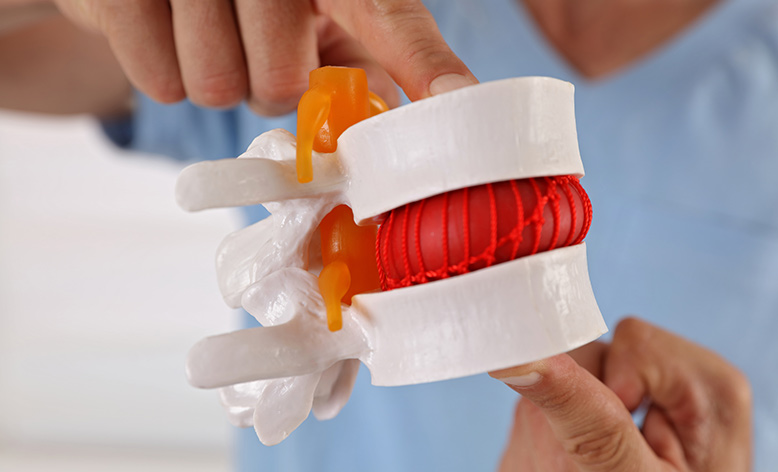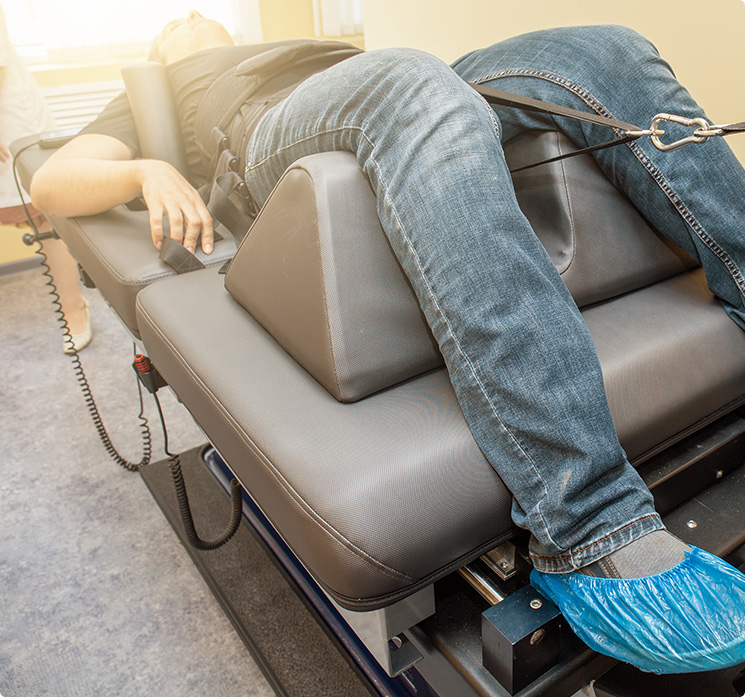Could you imagine going through life every day with near-debilitating, chronic back pain? Back pain is one of the most common ailments in America - it's estimated that 8% of all adults, or 16 million people, suffer from chronic back pain in the U.S. every year. If you've never experienced a back injury or pain, be thankful. Chronic back pain affects every aspect of a person's life, from participating in sports to limitations with everyday activities, like cooking dinner. In fact, many people with chronic back pain can't even make a reliable living and put food on the table. Almost 83 million workdays are lost every year due to choric back pain.

The inability to work and provide isn't just a physical issue - it can become an emotional one too. Many people suffering from chronic back pain also suffer from depression and anxiety. Unfortunately, in the past, chronic back pain sufferers wanting to avoid addictive medications and invasive surgeries had few viable relief options. However, if you're suffering from a chronic back issue like sciatica, a pinched nerve, or a bulging disc, pain relief may be closer than you think.
Modern chiropractic care and, more specifically, a spinal decompression chiropractor in West Ashley, SC, may be the long-term solution you need for chronic back pain.
A common misconception is that chiropractors only adjust your back and neck when, in fact, they treat the whole body with all-natural treatments. Here at Elite Healthcare, our doctors focus on your overall health, not just pain. We want to find and address the underlying causes of your symptoms. If you're unfamiliar with an integrative approach to medicine, this strategy may seem new. Our chiropractic care is less about putting a band-aid on the problem and more about finding a natural, long-term solution to your pain.
Fortunately, our experienced chiropractors provide the best in natural pain relief. Prescription and over-the-counter pain medications mask the symptoms you're experiencing versus getting to the cause of your pain. Pain is often the result of your spine being out of alignment, which leads to nerve issues. Once your spine is back in alignment, the nerves function correctly again.
Because our chiropractic center offers a combination of different therapies and non-surgical treatments, we provide a comprehensive approach to healing. Depending on the extent of your back problems, spinal decompression therapy may be the answer to your chronic pain problems.
Initially developed in 1985 by Dr. Allan Dyer, spinal decompression has been used by chiropractors for years. Unfortunately, spinal decompression is often passed over as a viable treatment, despite its numerous benefits.
In the past, patients suffering from chronic back pain issues like herniated discs were usually prescribed powerful medications. They were instructed to refrain from physical activities, referred to a physical therapist, and sent on their way. While physical therapy has an important role in back pain recovery, some back conditions need a more comprehensive treatment approach. For those patients, surgery seemed like the only option.
Today, patients with chronic back pain have many more options to consider. One of the most effective treatments for serious back pain is spinal decompression. This proven therapy, provided by Elite Healthcare, has been shown to significantly reduce pain and help patients live a normal, even active lifestyle once again.

Spinal decompression, also called Lumbar Cervical Decompression Therapy (LCD Therapy), is a very effective non-surgical solution to chronic back pain problems. If you're like most patients, your back pain is caused by disc issues related to your spine. This type of therapy uses computer technology and a spinal decompression machine in cityname, state, to stretch your spinal column slowly and gently, relieving abnormal pressure on the discs in your back, which sit in between your vertebrae.
This precise stretching action causes negative pressure to form inside the discs in your back, making them retract. With time, this negative pressure causes a reverse vacuum of sorts that actually draws your protruding discs into place. When pressure is removed from the disc segments in your spine, you experience much-needed pain relief.
The primary purpose of spinal decompression therapy is to provide you with immediate pain relief while creating a healthy environment to heal your spinal disc condition. Some of the most common conditions that spinal decompression therapy treats include:
This happens when spinal discs in your back are pushed outside of the spinal canal. When pushed outside of their usual space, these discs can put pressure on the nerves in your spine, resulting in localized pain and pain throughout your body. If a bulging disc is left untreated, it has a high chance of rupturing, which can necessitate surgery and longer recovery time.
Herniated discs are discs in your back that fracture or crack and leak fluid. The fluid or gel that leaks from a herniated disc may irritate the nerves in your back. When this happens, you may experience an intense burning sensation that shoots up and down your lower back and legs.
As you grow older, joints in your body, like your knees and hips, begin to wear away with time. The same thing can happen to the discs in your back. Often caused by heavy lifting or a family history of spine problems, degenerative discs are painful and can lead to serious situations. In advanced cases, bone spurs can form and affect the nerves of your spine.
When a herniated disc or bone spur begins to put pressure on the nerves in your back, it often causes sciatica. Sciatica is a common back problem that causes pain to radiate from your lower back down your legs via your sciatic nerve. Sometimes, this pain is only felt in one of your legs.
This condition is similar to arthritis of your spine, where the cartilage inside your facet joint breaks down and becomes inflamed. The result is often intense neck and back pain. It's most often caused by degenerative changes in the joints located between the bones of your spine.
This painful condition manifests when the space in your backbone is too small. When this happens, pressure impacts your spinal cord and the nerves that travel through it. Like other conditions treated by a spinal decompression therapy cityname, state, stenosis is caused by wear-and-tear in your back, which forms arthritis.
This term is often used to classify a range of back problems, most often caused by a pinched nerve root in your spinal column. This pinched nerve root may occur in different locations down your spine, like the lumbar or thoracic areas. Usually caused by a narrowing of the space where your nerve root leaves the spine, symptoms of this condition include pain, tingling, numbness, and weakness.
If you're looking for a safe way to relieve your chronic back pain, spinal decompression should be on your list of treatments to consider. This painless procedure is backed by research showing higher success rates in many patients when compared to spinal surgery. Unlike many medications, spinal decompression from Elite Healthcare Physical Medicine is designed to correct the condition you're facing while also minimizing costs and eliminating recovery and downtime.
Some of the most popular reasons why patients choose spinal decompression over surgery and other treatments include:
Invasive procedures, like back surgeries, often leave the patient racked with pain, long recovery times, and complications. Sometimes, the surgery doesn't work as intended, leaving the patient responsible for a therapy that didn't work correctly. As a non-invasive treatment, spinal decompression therapy can treat back and neck pain without needles, incisions, or harmful manipulations of the spine.

Getting back pain relief from surgery is far from guaranteed. However, because spinal decompression targets the underlying causes of your back pain, it's a much more effective long-term treatment. Spinal decompression is not a quick fix. When coupled with positive lifestyle changes like losing weight, you can maximize the pain-relieving benefits of spinal decompression.

Surgery of the back and spine requires the patient to be bedridden and uncomfortable for days and even weeks. Recovering from back surgery is no easy feat and often requires strong pain medications to help. Sometimes, back surgeries don't go as planned, causing complications and worse scenarios. Spinal decompression, on the other hand, is very effective and doesn't require much recovery time at all. Once your spinal decompression session is over, you'll probably be able to drive yourself home from our office.

One of the least talked about issues with back pain medications is that they only treat the pain, not the underlying causes. For many patients, relying on meds to relieve back pain fosters dependency on pain pills. Pain pill addiction is a very serious issue in the U.S., often leading patients down a dark path. With spinal decompression, you won't have to worry about taking pills for pain relief. That's because the root causes of your back pain are addressed, not just the symptoms.

If you were to look at the cost of surgery and subsequent years of prescription medication, you might be shocked. When compared to spinal decompression, surgery is a much more expensive treatment to consider. You've got to take the cost of surgery into account, but also the fact that you'll be forced to take time off work. By choosing spinal decompression therapy, you're choosing a safe, non-surgical treatment that doesn't require any time off work.

Spinal decompression relieves pressure on disrupted discs, causing them to retract back into place. This revolutionary treatment also lets oxygen, fluids, and nutrients re-enter your spinal discs, which provides additional healing.
 (843) 936-6238
(843) 936-6238

By now, you probably have a better idea of how spinal decompression can help rid your life of back pain. But spinal decompression treatment does more than help with bulging discs, herniated discs, arthritis, and more. It has also been shown to provide patients with important quality-of-life benefits.

As mentioned above, harsh surgeries leave you bedridden and unable to work for long periods of time. Spinal decompression allows you to jump right back into the workforce, so you can continue providing for your family. Plus, reducing your back pain naturally increases your mobility since you won't be stressing about hurting yourself while moving. Instead, you'll be living in the moment.
One of the worst symptoms affecting people with back pain is the inability to sleep well. Sleeping with back pain can be horrible, causing you to toss and turn to find a comfortable spot. As soon as you find one and get settled, your back starts to hurt again. It's a vicious cycle, but adjusting your spine and relieving pressure with spinal decompression will help you get a good night's rest.
Did you know that when your spine is decompressed, it helps fluids circulate throughout your body? These fluids actually flush your lymphatic system, which helps support your overall immune system. Better circulation also benefits your brain and can help boost concentration and memory. The improved circulation from spinal decompression may also distribute oxygen and nutrients to your skin, creating a multi-benefit effect.
We are happy to answer your questions, and help you find the services you need. Please message us to get started.
At Elite Healthcare Physical Medicine, we practice an integrated approach to pain relief and chiropractic care. Our goal is to restore your spine to its proper alignment, which speeds up your recovery time and prevents additional injuries. If chronic back pain has taken over your life, it's time to visit our chiropractic office for a thorough evaluation.
Ask yourself this: Have you been suffering from headaches and sleepless nights due to muscle strain? Is your ability to work and put food on the table compromised due to a pinched nerve? No amount of over-the-counter pain medication can provide a long-term fix for such an issue. Thankfully, our chiropractors have years of experience providing relief to patients just like yourself.
After a comprehensive exam, our doctor will create an individualized treatment plan tailored to your body. That way, we can address the full scope of your symptoms by correcting any root causes of your back pain.
From minor chiropractic adjustments to spinal decompression treatment, we'll find the solution that your back and body need to heal correctly. If you're ready to get back on the road to better health, we're here to help every step of the way. Contact our Elite Healthcare Physical Medicine today to get started.
 (843) 936-6238
(843) 936-6238
CHARLESTON, S.C. (WCIV) — West Ashley is home to South Carolina’s first-ever food forest.Funded through a $50,000 grant from the South Carolina Forestry Commission, Charleston Parks Conservancy launched the project with the City of Charleston and other partners to provide free and nutritious options in areas struggling with food insecurity.“In the end, this will end up producing about 30,000 pounds of fresh organic produce, in a community that doesn't have great access to healthy foods,” said Darlene Hea...
CHARLESTON, S.C. (WCIV) — West Ashley is home to South Carolina’s first-ever food forest.
Funded through a $50,000 grant from the South Carolina Forestry Commission, Charleston Parks Conservancy launched the project with the City of Charleston and other partners to provide free and nutritious options in areas struggling with food insecurity.
“In the end, this will end up producing about 30,000 pounds of fresh organic produce, in a community that doesn't have great access to healthy foods,” said Darlene Heater, executive director of Charleston Parks Conservancy.
Rows of more than 75 plants, ranging from nut trees to berry bushes, line Mulberry Park in West Ashley.
READ MORE: "Hendrick Automotive Group donates $100,000 to Lowcountry Food Bank."
The first in the state, Charleston’s new food forest will provide free, fresh produce to those who need it most.
“What's beautiful about a food forest is that anybody can access it at any time. So, you're not relying on someone's opening hours or the availability to be able to go to a source to get food,” Heater said. “It is in the community and available to the community for whoever needs it.”
The forest features seven tiers of agriculture and will begin producing roughly $25,000 worth of food annually in the first five years.
The conservancy has worked with several local groups, like Slow Food Charleston, to make the flagship project come to life.
“To help bring good, clean, and fair agricultural products to our community, to communities that may not have access to them. To have them engage in a manner that is enriching,” said Kellie Holmes, co-chair of Slow Food Charleston.
READ MORE: "Hansley's Free Fridge project is fighting food insecurity in South Carolina."
Accessibility is at the root of it all.
The food forest is in the Ardmore neighborhood, a lower-income area that could be categorized as a food desert. It isn't an uncommon issue. Around 40.5 million Americans live in USDA-designated food deserts nationwide.
“Mulberry Park is an ideal location. It is a community that, though it has some grocery stores in its vicinity, they are not necessarily grocery stores that everyone in the community can afford to go to,” Heater explained.
Located off the Bikeway, Charleston Parks Conservancy hopes the food forest will feed not only its closest neighbors but the greater West Ashley and Charleston area.
Pluck an apple, cut some herbs or pick some berries at South Carolina's first food forest, a new free-of-charge grove being built in the Ardmore community.With an expected seven stories of canopies and an estimated $25,000 annually in produce by its fifth year, Charleston Parks Conservancy director Darlene Heater acknowledged it's a remarkable undertaking for the local nonprofit."It's creating access ...
Pluck an apple, cut some herbs or pick some berries at South Carolina's first food forest, a new free-of-charge grove being built in the Ardmore community.
With an expected seven stories of canopies and an estimated $25,000 annually in produce by its fifth year, Charleston Parks Conservancy director Darlene Heater acknowledged it's a remarkable undertaking for the local nonprofit.
"It's creating access in food deserts but creating it in a way that is low-maintenance and little barrier for people to be able to participate in it," Heater said.
The food forest on Mulberry Street near Grech Street, and off the West Ashley Bikeway, is being funded by a $50,000 grant from the South Carolina Forestry Commission.
While the conservancy is handling the horticulture, the City of Charleston's parks department is working to excavate the land, add pathways and install a new playground at the park. It is one of several conservancy projects this year, in addition to working with the city to manage 24 parks on the peninsula, on James Island and in West Ashley.
Parks Department director Jason Kronsberg compared the collaboration between the city, the conservancy and the community to a three-legged stool. The conservancy liaises with the neighborhoods, like Ardmore for the food forest, and then fundraises with them before going to the city to bring a project to life.
The food forest is intended to help the Ardmore neighborhood, recently identified in the Charleston parks master plan as a community of high need, along with the surrounding community.
Besides providing free access to produce, the forest can help people better understand where their food comes from, Kronsberg said. It's also an opportunity for folks to lend a hand with some maintenance.
"The parks are owned by everybody," Kronsberg said.
The project will not be without its challenges, though. As the weather in Charleston gets more severe, Heater said that the conservancy will need to tend to the forest carefully and make sure plants or produce don't wash away.
Teaching the community how to use — and not overuse — the one-of-a-kind forest will take time, too.
The conservancy plans to lean on its volunteer base to maintain the forest, such as harvesting, packing and sending excess produce to local nonprofits. There will be no constraints on harvesting to start, as to not adversely impact food accessibility, Heater said. Part of it will be trial and error, and much of the plan is flexible based on the demand the conservancy sees for certain produce.
"What we may learn is that this community really loves sweet potatoes but doesn't care as much about turnips," Heater said. "So let's look at how we can expand growing our sweet potato patch so that we can continue to serve the people adequately who most need it."
This spring will mark the first planting of the fruit trees, brambles and herbs. Heater said that best practices dictate not harvesting during the first year, so by the second year the conservancy expects to have herbs, mushrooms, brambles and possibly bananas to harvest.
By the fifth year, with an estimated 70 trees bearing fruit, Heater said she expects 10,000 pounds of produce.
The food forest comes two years after the adoption of a new Charleston parks master plan and months after the overwhelming approval of a bond referendum question last November.
"Citizens spoke loudly and clearly that they supported the referendum and improved park spaces," Kronsberg said. "Coming out of COVID, when parks became critical infrastructure, it was natural that there was that much support for a referendum."
As the Ardmore food forest begins to yield, relieving supply-chain issues might just become an additional perk. And in a world reshaped after the pandemic, the food forest is one project that shows how to branch out from the traditional park.
There are many challenges to growing fruit, from soil quality to harsh climates for plants and, often, these plantings do not last a particularly long time. Yet there is hope to have fresh fruit in the landscape, and the way this is accomplished is by planting more unique and lesser-known fruit trees and shrubs. One shrub is not only a perfect choice for growing here, but it also has excellent ornamental value as well: the blueberry.
Blueberries are a group of plants usually in the Vaccinium genus, most of which are native to North America. They are members of the Ericaceae family, along with the Rhododendron genus that includes azaleas. There are dozens of species and even more cultivars of blueberries, making selection somewhat confusing.
That being said, there are two main types grown here in the Lowcountry. There is the southern highbush blueberry, V. corymbosum. This group has low chill hour requirements and has decent heat tolerances. Then there is the rabbiteye blueberry, V. virgatum, which is more adaptable to the state and is a perfect choice for the home garden. The rabbiteye blueberry is the preferred species here in the Lowcountry due to its adaptability, productivity and pest tolerance.
As mentioned previously, there is a major consideration when selecting the cultivar of blueberry: chill hour requirements. Chill hours refers to the number of hours below 40 degrees Fahrenheit the plant needs in order for flowers to develop. If the required number of hours is too high, then it would be unlikely the shrub will ever produce flowers or fruits in the Lowcountry. If the required number of hours is too low, then the flowering may commence too early in the year at the first sign of warm weather and thus be damaged by the subsequent frosts. Here, along the coast, the approximate number of hours is 400-600.
The other thing to keep in mind is that, while blueberries are considered self-fertile, fruit production increases with cross-pollination. Rabbiteye blueberries have issues with self-incompatibility, making cross-pollination necessary in order for better fruit development. Ideally, two or more cultivars are required for proper fruit production. Rabbiteye blueberries have the greatest degree of self-incompatibility, whereas southern highbush are better suited to be self-fertile — though it is still recommended to have two or more types.
Growing and maintaining blueberries is relatively simple once they are established, but proper site selection is essential. Blueberry plants prefer well-drained, acidic soil to thrive. These are by far the most common issues with stunted blueberry plants. The pH recommendation for blueberries is between 4.5 and 5.5. A pH above a 6.0 can stunt the plant permanently. It is imperative to have a soil test done before planting to determine the pH. Once a shrub is stunted due to improper pH, the plant generally does not recover.
Pruning when first planted is paramount. This enhances survivability and encourages more vigorous growth the following year. It is also necessary to remove any shoot tips that have flower buds (swollen rounded buds) for the first couple of seasons. This spurs vegetative growth, since reproduction requires tremendous energy.
By the third season, there should be a multitude of shoots, which will greatly increase flower production. As the plants grow after being established, it is recommended to prune consistently to keep down insect issues as well as encourage healthy growth. The best time to prune established shrubs is from January to March, before the buds set.
One of the best aspects of this group of fruit-bearing shrubs is not only the ease of care and the overall value added to any landscape but the ecological benefit they provide. As mentioned previously, blueberries are native to North America, and with that comes important relationships with native pollinators. Blueberries, in particular, have a group of bees, known as blueberry bees. These bees need the flowers of the Vaccinium genus. The importance of planting native plants cannot be overstated, and this a great way to bring any landscape one step closer.
CHARLESTON, S.C. (WCSC) - Residents who live near one West Ashley development learned more about the future of their community during a meeting hosted by developers.Cameron Property Company, the company overseeing the development of 26 acres near the Essex Farms community, invited residents to share their concerns and provide input at a meeting Thursday night.The 26-acre lot runs from Essex Farms Drive, down Skye Drive and extends to Dorothy Drive.Developers were accompanied by Charleston city officials representing the ...
CHARLESTON, S.C. (WCSC) - Residents who live near one West Ashley development learned more about the future of their community during a meeting hosted by developers.
Cameron Property Company, the company overseeing the development of 26 acres near the Essex Farms community, invited residents to share their concerns and provide input at a meeting Thursday night.
The 26-acre lot runs from Essex Farms Drive, down Skye Drive and extends to Dorothy Drive.
Developers were accompanied by Charleston city officials representing the council, planning department, and traffic department to discuss what potential businesses residents could expect to see.
During the meeting, community members said they were relieved to learn that the developer withdrew its request to change the zoning language to include drive-thru windows at restaurants.
The developer is in talks with a grocery store and gas station, but plans have not been finalized.
Some residents said they are less than pleased about the big changes coming to the Essex Farms community.
Residents also expressed concerns about traffic congestion and the potential for a gas station to be built on the property.
“Tonight’s the first time we’ve heard gas station. That was a shock for all of us. When we purchased our properties, we were told specifically that a gas station wasn’t allowed to be there,” resident Kellie Kinard said.
Development Manager Collins Moe said he wants community input but that the company has the right to build to the zoning order, which does allow a grocery store and gas station.
“We’re going through the appropriate city of Charleston permit steps which require traffic studies. Things that outline what we’re proposing to make sure they meet all the standards with the county, the state, and the city, more importantly, based on where this property lies. At the end of the day, we’re still very far out,” Moe said.
Kinard said she is disappointed and was left with even more concerns and questions.
“I think my husband and I are going to have a serious conversation about whether or not we’re going to list our home. Which is really unfortunate because we love our neighborhood. We have great neighbors, but we do not want this type of development that they’re talking about potentially literally within several feet of our driveway,” Kinard said.
City officials stated that this development was approved many years ago and the zoning goes back to 1997.
Copyright 2024 WCSC. All rights reserved.
The wide land west of the Ashley River is home to comfortable tree-lined streets with rows of homes, highways flanked by businesses and malls, villages like Avondale and emerging plans for revitalization.With a 2022 population of 83,996 people, West Ashley is the epicenter of Charleston, even though most people consider the peninsula to be more population.“What makes West Ashley special is the people,” said West Ashley Realtor Shana Swain, a former bartender with connections throughout the suburb. “It’s ...
The wide land west of the Ashley River is home to comfortable tree-lined streets with rows of homes, highways flanked by businesses and malls, villages like Avondale and emerging plans for revitalization.
With a 2022 population of 83,996 people, West Ashley is the epicenter of Charleston, even though most people consider the peninsula to be more population.
“What makes West Ashley special is the people,” said West Ashley Realtor Shana Swain, a former bartender with connections throughout the suburb. “It’s where the heart of Charleston is.”
West Of newspaper editor Lorne Chambers agreed, describing residents as having a “scrappy spirit.”
“They are not your traditional downtown Charleston people, but they are real Charlestonians,” he said. “In a way, this is the original Charlestown,” he said. “You have a lot of people over here who have a lot of pride in their community and hope for a better tomorrow.”
Dominated before World War II by farms and pastures, West Ashley bloomed into a middle-class suburban haven replete with everything from mind-numbing rush-hour traffic to chain stores that you can find in Columbus, Ohio.
But with a controversial development project being discussed at the former Piggly Wiggly site on Sumar Street and Ashley River Crossing, a planned pedestrian bridge connecting West Ashley and downtown, a question is what direction is the suburb headed.
The West Ashley Revitalization Committee has been spearheading the suburb’s path toward development. The committee’s Plan West Ashley aims for ambitious changes from economic development to flood prevention.
The Sumar Street development project was postponed in June, causing doubts about the strength of the committee’s plans.
City Councilman Karl Brady represents outer West Ashley. A board member of the West Ashley Revitalization Commission, he said West Ashley projects like the Sumar Street development project, were voted down by people who don’t have a vision for the future.
“They see West Ashley as it is but not as what it could be,” he said.
Brady, who currently is running for reelection, said that in revitalization it is important to remember where West Ashley started. It was the birthplace of Charleston when settlers landed at Charles Towne Landing in 1670.
“I think one thing lost on a bunch of people is that West Ashley is the birthplace of Charleston. That’s how we should treat it.”
Chambers, a former Charleston City Paper employee, said West Ashley is planning in the right direction, but there is not much to show for it.
“In people, you are seeing this shift away from these traditional big-box stores towards giving more community pride,” he said. “But we have to stay the course.”
Chambers said the community has historically wanted more than malls and commutes, but often ended up with Walmarts and chain businesses regardless.
Malls, he said, are a product of West Ashley’s suburban boom in the 1980s. The “retail apocalypse” of the 2010s crippled them. Now, West Ashley has a lot of vacant lots. Chambers said because the area is growing, some residents want to shed the concrete.
“Most citizens in West Ashley didn’t want another mall or gas station,” he said.
Donna Jacobs is a West Ashley historian and author. As a former board member of Plan West Ashley, Jacobs noticed a generational difference in what residents plan for their neighborhoods.
Jacobs said the West Ashley area has been split between two different models of how to live and build. It also is split between two different generations of Americans and what they want for the future.
In many ways, these splits are between those “inside the loop” and those “outside the loop,” meaning those who live north of the swath cut by Interstate 526 and those who live south of it — an area generally with more land and open space.
She said those who live inside 526 advocate for a walkable Avondale plan. But those outside of the interstate often want to keep West Ashley’s traditional shopping centers.
“Inside the loop, some of these younger residents would happily ride their bikes to work every day and walk their kids to school, regardless of the weather,” she said.
But others see cars as their primary way of commuting, “They kind of expect those old West Ashley malls to drive to,” she said.
Jacobs said the diverse lifestyles and history of West Ashley was a strength for living in the area. She added she thought West Ashley was a nice place to live regardless of whether you believe in the Avondale approach or the mall.
Alex Nettless, a former City Paper intern, is a student at Elon University.
*Multiple locations
Population 83,996
Ethnicity68% White26% Black3% Hispanic
Median age 38.7
Median household income $68,898
Percent above $100,000 31%
Households below poverty line 10%
Households above $200,000 7.6%
Households 36,864
Occupancy52% owner-occupied40.0% rental7.7% vacant
Education19.1% are high school graduates.30.7% have bachelor’s degrees.16.5% have graduate degrees.
Apparel and services $82M
Education $65M
Entertainment, Rec $121M
Food at home $201M
Food away from home $144M
Health care $213M
Household furnishings $83M
Shelter $734M
Travel $89M
Help keep the City Paper free.
No paywalls.No newspaper subscription cost.Free delivery at 800 locations from downtown to North Charleston to Johns Island to Summerville to Mount Pleasant.
Help support independent journalism by donating today.
CHARLESTON, S.C. (WCBD) — Charleston city leaders are moving forward with plans to redevelop a shopping center on Sam Rittenburg Boulevard in West Ashley.The City of Charleston’s Design Review Board gave conceptual approval on Monday to a new Publix grocery store and retail space that will be built in the Ashley Landing Mall shopping center where a Publix currently sits.The existing Publix is located closer to Sumar Street and was built in the 90s. The new plans are to move the grocery store to the opposite side of ...
CHARLESTON, S.C. (WCBD) — Charleston city leaders are moving forward with plans to redevelop a shopping center on Sam Rittenburg Boulevard in West Ashley.
The City of Charleston’s Design Review Board gave conceptual approval on Monday to a new Publix grocery store and retail space that will be built in the Ashley Landing Mall shopping center where a Publix currently sits.
The existing Publix is located closer to Sumar Street and was built in the 90s. The new plans are to move the grocery store to the opposite side of the property closer to Charlestowne Drive and add new retail and restaurant space next door.
There is currently a 130,000-square-foot building in that spot, which includes businesses like Dollar Tree and Big Lots inside. The Design Review Board also moved forward with the approval of a partial demolition of the shopping center, which includes these businesses. Robert Summerfield, the city’s Director of Planning, Preservation and Sustainability, said the leases for the businesses were not renewed in preparation for the redevelopment of the area.
Summerfield added that the plans to revamp the shopping center are in line with the city’s goals to revitalize parts of West Ashley.
“This is right in line with the ideas for the plan, it keeps a major shopping experience with the grocery store right there — keeps it anchored in the community and in that shopping center for those neighborhoods in that area,” he explained.
However, Suzanne Germroth, who lives in Charleston, said she is concerned about the neighborhood losing the businesses currently there because of the project.
“A lot of people rely on these discount stores to maintain their livelihood and what they can afford,” she said. “And I don’t understand why this perfectly wonderful building here has to move across the street.”
Summerfield said the current Publix will stay open until the new one is complete, and the plans for what will happen with the existing Publix building have not been decided.
“Publix has actually done this in a number of places in the markets that they work in. You know they’ll close the store one night in its current space and they’ll open the next morning in the new space,” he said. “In the old space, that again will be I believe in phase two of their development plan.”
This was the first time the conceptual plans for the project went in front of the Design Review Board. The next step for the project will be a preliminary review.
